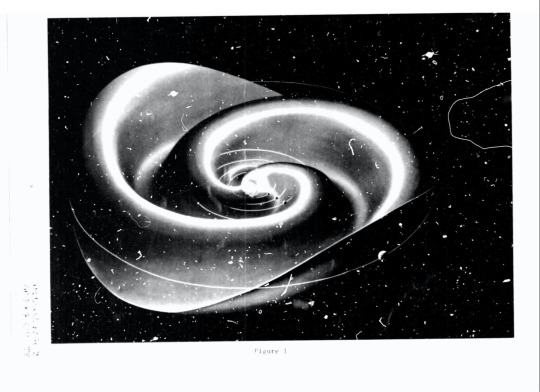#heliophysics
Text
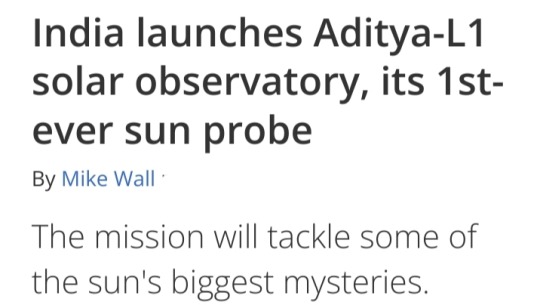
2 September 2022
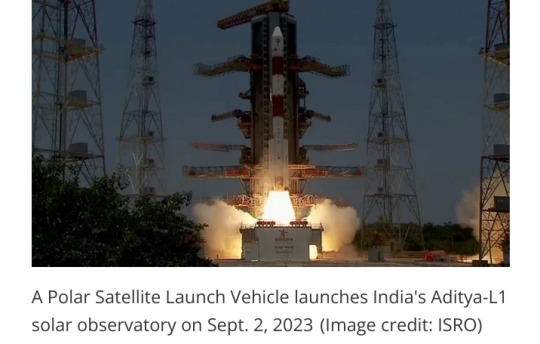
Fresh off its success at the moon, India is now headed for the sun.
The nation launched its first-ever solar observatory today (Sept. 2), sending the Aditya-L1 probe skyward atop a Polar Satellite Launch Vehicle (PSLV) from Satish Dhawan Space Centre at 2:20 a.m. EDT (0620 GMT; 11:50 a.m. local India time).
The PSLV deployed Aditya-L1 into low Earth orbit (LEO) as planned about 63 minutes after liftoff, sparking applause and high fives in mission control.
"Congratulations, India, and congratulations, ISRO [the Indian Space Research Organisation]," Jitendra Singh, India's Minister of State for Science and Technology, said shortly after deployment on ISRO's launch webcast.
"While the whole world watched this with bated breath, it is indeed a sunshine moment for India," Singh added.
The successful launch followed on the heels of another big milestone for India: On August 23, its Chandrayaan-3 mission became the first to land softly near the moon's south pole.
Chandrayaan-3's lander-rover duo are expected to conk out in a week or so, when the harsh lunar night falls at their touchdown site. But Aditya-L1's long journey has just begun.
A long road to a good sun-viewing spot
Aditya-L1 won't stay in LEO forever:
After a series of checkouts, it will use its onboard propulsion system to head toward Earth-sun Lagrange Point 1 (L1), a gravitationally stable spot about 1 million miles (1.5 million kilometers) from our planet in the direction of the sun.
That destination explains the latter part of the mission's name. And the first part is simple enough: "Aditya" translates to "sun" in Sanskrit.
The 3,260-pound (1,480 kilograms) observatory will arrive at L1 about four months from now, if all goes according to plan.
But the long trek will be worth it, according to the ISRO.
"A satellite placed in the halo orbit around the L1 point has the major advantage of continuously viewing the sun without any occultation/eclipses," ISRO officials wrote in an Aditya-L1 mission description.
"This will provide a greater advantage of observing the solar activities and its effect on space weather in real time."
Indeed, another sun-studying spacecraft is already at L1 — the Solar and Heliospheric Observatory (SOHO), a joint NASA-European Space Agency mission that launched in December 1995.
(Several other spacecraft, including NASA's James Webb Space Telescope, are at Earth-sun Lagrange Point 2, which is a million miles from Earth, in the direction away from the sun.)

Solar flares, the coronal heating mystery and more
Once it's settled in at L1, the solar probe will use four three science instruments to study the particles and magnetic fields in its immediate surroundings and four others to scrutinize the sun's surface (known as the photosphere) and its atmosphere.
This work will help scientists better understand solar activity, including the dynamics of solar flares and coronal mass ejections (CMEs), ISRO officials say.
Flares are powerful flashes of high-energy radiation, and CMEs are huge eruptions of solar plasma.
Both types of outburst can affect us here on Earth. Intense CMEs that hit our planet, for example, trigger geomagnetic storms that can disrupt satellite navigation and power grids.
(As a side benefit, such storms also supercharge the gorgeous light shows known as auroras.)
Aditya-L1 will also tackle the "coronal heating problem," one of the biggest mysteries in heliophysics.
The corona — the sun's wispy outer atmosphere — is incredibly hot, reaching temperatures around 2 million degrees Fahrenheit (1.1 million degrees Celsius), according to NASA.
That's about 200 times hotter than the solar surface, which is "only" 10,000 degrees F (5,500 degrees C) or so.
It's still unclear what is responsible for this startling and counterintuitive discrepancy.
(Why would it be hotter away from the sun's core, where the energy-producing nuclear fusion reactions are occurring?)
Aditya-L1 has other science goals as well. For instance, the mission also aims to more fully flesh out the solar wind, the stream of charged particles flowing constantly from the sun, ISRO officials said.
Aditya-L1 will measure the composition of the solar wind and attempt to determine how it is accelerated.
And Aditya-L1 will do all this work on the cheap:
The mission's price tag is about 3.8 billion rupees, or $46 million US at current exchange rates.
That's in the same ballpark as Chandrayaan-3
India's first successful moon-landing mission costs about 6.15 billion rupees, or $74 million US.
For comparison, NASA's most recent big-ticket sun mission, the record-setting Parker Solar Probe, costs roughly $1.5 billion.
This disparity should not be viewed as an indictment of NASA, however; labor costs are much higher in the United States than in India, among other differences between the two nations' economies.
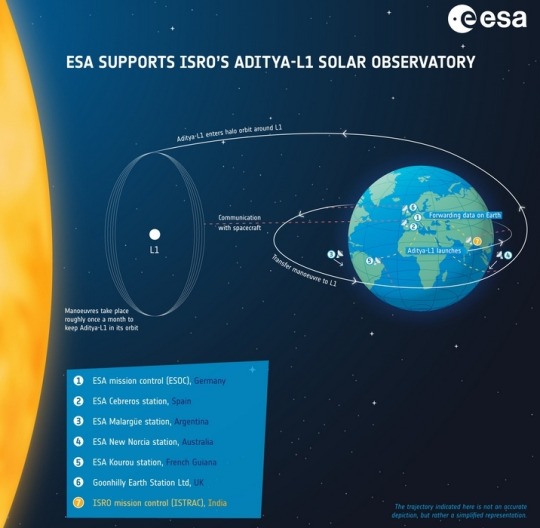
Aditya-L1 is a coronagraphy spacecraft to study the solar atmosphere, designed and developed by the Indian Space Research Organisation (ISRO) and various other Indian research institutes.
#India#Aditya-L1#Polar Satellite Launch Vehicle (PSLV)#Satish Dhawan Space Centre#low Earth orbit (LEO)#sun#Indian Space Research Organisation#Chandrayaan-3#Earth-sun Lagrange Point 1 (L1)#Solar and Heliospheric Observatory (SOHO)#solar flares#coronal mass ejections (CMEs)#coronal heating problem#heliophysics#solar wind#Parker Solar Probe#NASA#solar observatory#solar atmosphere
12 notes
·
View notes
Text

I didn't take my professional camera equipment bc I wanted to experience the moment but I'm delighted by this quick shot I managed to capture in central Ohio with the night vision mode on my camera. You can barely see Venus on the lower right and Jupiter on the upper left as well as the beautiful corona
#my photo#sun#astrophotography#solar eclipse#solar eclipse 2024#planets#amateur astronomy#heliophysics#do you love the color of the sky#ohio
6 notes
·
View notes
Text


- Wednesday, May 3, 2023 -
The Spring 23 semester has officially come to a close, and now that I have no homework I'm literally sitting at my desk like

T minus 19 days until the start of my heliophysics REU at UAH, I need to get myself some clothes asap lol
I recently received the title of my project and learned that I'll be working on simulating active regions of the sun which I think is SUPER cool. I can't wait to get started!! I'm thinking I'll definitely be more active on the daily while I'm in Alabama for that. I want to keep a decent blog of that both for sharing and for myself to keep record of this incredible experience.
I think that's all for now, stay safe ❤️
images above: pen on my arm reading "fuck it, we bawl" with a teardrop smiley underneath, and a basic leaf latte art I somehow managed at work recently.
#college#study blog#studyblr#studying#stem students#uni#college student#study aesthetic#study with me#latte#latte art#fuck it we ball#end of the semester#summer#heliophysics#astrophysics major
11 notes
·
View notes
Text
New(er) Horizons! 🛰️

Originally sent out to studying Pluto in 2006, the mission has been updated to extend its lifetime operation into 2029

Launched on January 18, 2006, NASA’s New Horizons spacecraft has helped scientists understand worlds at the edge of our solar system by visiting the dwarf planet Pluto (its primary mission) and then venturing farther out for a flyby of the Kuiper belt object Arrokoth, a double-lobed relic of the formation of our solar system, and other more remote observations of similar bodies
This new, extended mission will be primarily funded by NASA’s Planetary Science Division and jointly managed by NASA’s Heliophysics and Planetary Science Divisions
“The New Horizons mission has a unique position in our solar system to answer important questions about our heliosphere and provide extraordinary opportunities for multidisciplinary science for NASA and the scientific community,” said Nicola Fox, associate administrator for NASA’s Science Mission Directorate in Washington. “The agency decided that it was best to extend operations for New Horizons until the spacecraft exits the Kuiper Belt, which is expected in 2028 through 2029.”
More information from the Principal Investigator (PI) Alan Stern
For a more complete overview of Pluto and New Horizons: The Pluto System After New Horizons by NASA's New Horizons Principal Investigator Alan Stern, et al

#new horizons#nasa#nasa jpl#Pluto#kuiper belt#heliophysics#planetary science#nasa breaking news#book recommendations#book recs#textbook
5 notes
·
View notes
Text
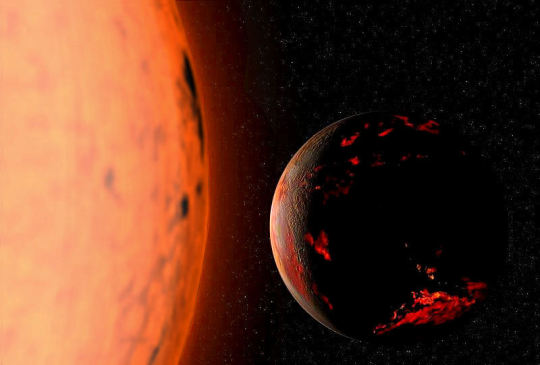
“In about one billion years, the solar luminosity will be 10% higher, causing the atmosphere to become a ‘moist greenhouse’, resulting in a runaway evaporation of the oceans. As a likely consequence, plate tectonics and the entire carbon cycle will end. Following this event, in about 2–3 billion years, the planet's magnetic dynamo may cease, causing the magnetosphere to decay and leading to an accelerated loss of volatiles from the outer atmosphere. Four billion years from now, the increase in Earth's surface temperature will cause a runaway greenhouse effect, creating conditions more extreme than present-day Venus and heating Earth's surface enough to melt it. By that point, all life on Earth will be extinct. Finally, the most probable fate of the planet is absorption by the Sun in about 7.5 billion years, after the star has entered the red giant phase and expanded beyond the planet's current orbit.”
Wikipedia contributors, "Future of Earth" (Sep 11, 2023).
#extinction#solar luminosity#stellar evolution#solar evolution#red giant phase#heliophysics#astronomy#indexmiscellany
2 notes
·
View notes
Video
NASA’s NuSTAR Telescope Reveals Hidden Light Shows on the Sun by NASA's Marshall Space Flight Center
Via Flickr:
Even on a sunny day, human eyes can’t see all the light our nearest star gives off. A new image displays some of this hidden light, including the high-energy X-rays emitted by the hottest material in the Sun’s atmosphere, as observed by NASA’s Nuclear Spectroscopic Telescope Array (NuSTAR). While the observatory typically studies objects outside our solar system – like massive black holes and collapsed stars – it has also provided astronomers with insights about our Sun. In this composite image, NuSTAR data is represented as blue and is overlaid with observations by the X-ray Telescope (XRT) on the Japanese Aerospace Exploration Agency’s Hinode mission, represented as green, and the Atmospheric Imaging Assembly (AIA) on NASA’s Solar Dynamics Observatory (SDO), represented as red. NuSTAR’s relatively small field of view means it can’t see the entire Sun from its position in Earth orbit, so the observatory’s view of the Sun is actually a mosaic of 25 images, taken in June 2022. The high-energy X-rays observed by NuSTAR appear at only a few locations in the Sun’s atmosphere. By contrast, Hinode’s XRT detects low-energy X-rays, and SDO’s AIA detects ultraviolet light – wavelengths that are emitted across the entire face of the Sun. Image Credit: NASA/JPL-Caltech/JAXA #nasa #marshallspaceflightcenter #msfc #heliophysics #sun #space #solar #observation #star #astronomy #science #hinode #SDO #SolarDynamicsObservatory #NuSTAR Read More More about NuSTAR More about Solar Dynamics Observatory More about Hinode NASA Media Usage Guidelines
#NASA#NASA's#Marshall#Space#Flight#Center#Heliophysics#Sun#Hinode#NuSTAR#SDO#Solar Dynamics Observatory#Goddard Space Flight Center#GSFC#flickr
3 notes
·
View notes
Text

Our active sun as captured by NASA's Nuclear Spectroscopic Telescope Array (NuSTAR), Japan's Hinode spacecraft and NASA's Solar Dynamics Observatory (SDO).
2 notes
·
View notes
Text
Scientists Pursue the Total Solar Eclipse with NASA Jet Planes
In the past, solar eclipses have driven numerous scientific discoveries. For this solar eclipse, NASA is funding several scientific experiments – including the three using the WB-57s – to make measurements during the eclipse. NASA’s WB-57s fly much higher than commercial aircraft. This altitude allows the jets to fly above clouds – meaning no chance of missing the eclipse due to bad weather.…
View On WordPress
#2024 Solar Eclipse#Eclipses#Heliophysics#heliophysics division#ionosphere#skywatching#Solar Eclipses#space weather#Sun#the sun solar physics#wb 57
1 note
·
View note
Link
ISRO announced the successful launch of the ASPEX experiment and revealed plans to study solar wind using Aditya-L1 The Indian space agency ISRO (Indian Space Research Organization) announced that the Aditya Solar Wind Particle Experiment (ASPEX) payload on board the Indian Aditya-L1 satellite has begun to function normally. Aditya-L1 was launched on a PSLV-C57 launch vehicle from Sriharikota on September 2. The satellite is placed in a halo orbit at the L1 Lagrange point, located between the Earth and the Sun. The goal of the Aditya-L1 project is to study solar wind and space weather. The information obtained by the satellite will reveal the origin, acceleration and direction of the solar wind, as well as understand its impact on Earth. [caption id="attachment_85365" align="aligncenter" width="780"] Aditya-L1 mission[/caption] Aditya-L1 mission: instruments begin collecting data on space weather and solar wind Aditya-L1 is the second ISRO spacecraft to move beyond the Earth's gravitational sphere of influence after the successful Mars Exploration Mission. Aditya-L1 carries seven scientific instruments, including four solar observation instruments and three plasma and magnetic field measurements. ASPEX includes two important instruments: the Solar Wind Ion Spectrometer (SWIS) and the High Energy Particle Spectrometer (STEPS). STEPS was launched on September 10th and SWIS started on November 2nd this year and has already shown results. SWIS, using two sensor units with a full 360° view, operates in planes perpendicular to each other. This spectrometer monitors solar wind ions, particularly protons and alpha particles. According to ISRO, SWIS has successfully measured these particles, which are a major contributor to the solar wind. An energy histogram obtained from one of the SWIS sensors over two days in November shows changes in the number of protons (H+) and alpha particles (He2+). These data provide a rich set of information about the behavior of the solar wind. This measurement will help resolve questions about the properties of the solar wind, its basic processes and influence on the Earth. Also, the change in the proportion of protons and alpha particles observed by SWIS has the potential to provide indirect information about the occurrence of coronal mass ejections at the L1 Lagrange point. After careful analysis of the collected data, the scientific community expects to gain new knowledge about the characteristics of the solar wind and its impact on Earth from the ASPEX experiment on the Aditya-L1 satellite.
#Aditya_L1_mission#Aditya_L1_launch_date.#Aditya_L1_spacecraft#heliophysics#Indian_Space_Research_Organisation_ISRO#ISRO_space_missions#solar_corona#solar_dynamics#Solar_Mission#solar_observation#solar_radiation#solar_wind#space_exploration#space_mission#space_mission_objectives#space_observatory#space_research#space_science#space_technology#sun_exploration
0 notes
Text
Opinion: New Horizons should remain a planetary mission
NASA’s New Horizons mission spacecraft. Image Credit: NASA
A little-known proposal is threatening the future of NASA’s New Horizons mission, and for reasons unknown, the space press has hardly reported on this development.
Continue reading Untitled

View On WordPress
1 note
·
View note
Photo

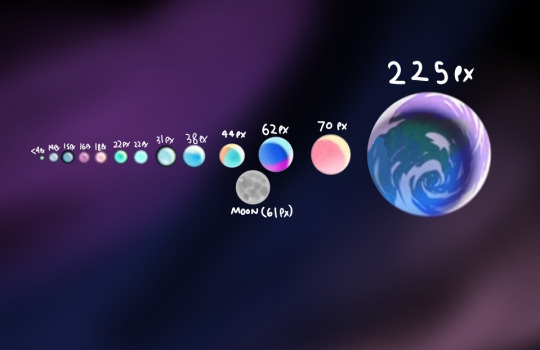
Etheria’s moons to dubious scale. The second from the right, the blue & purple one, is about the same size compared to Etheria as the Moon is compared to the Earth.
Probably the first thing I noticed when I watched She-Ra and the Princesses of Power was all the damn moons. I’d seen screenshots and clips of the show taking place on a space ship, so I figured “Brightmoon” was literally the name of a moon. But nope--the Starship Darla wouldn’t make her appearance until much later. Anyway. Despite the unrealistic appearance of the moons in the show, I resolved to Figure Out How They Work Eventually. Here’s some thoughts so far.

I’m unwilling to trust most of these sizes because of perspective effects and because it’s a cartoon. I think probably they’re all smaller than it seems. Obviously the “real” spacing is completely different than in the drawing.
If this image is taken with a telescope, or even a telephoto lens from sufficiently far away, then the original image scale could correspond to the scale of the actual planets.
we only have actual depth information for ONE moon--the blue and purple one in front of Etheria, which means its actual scale relative to Etheria is probably smaller than in the image.
each other moon could be either very large and distant or very small and near to the camera, but the way it looks in some scenes moving towards Etheria suggest that the moons are depicted not much farther or closer from the camera than Etheria itself, so I think taking these as roughly to-scale can serve as a starting point for figuring the rest out.
My progress so far in figuring out how to fit 11 large moons into orbit around one Earthlike planet:

this is only five. Four ceres in a near 1:2:4:8 resonance (such that triple conjunctions are possible, but rare), with that pink moon represented as a Mars-mass world, orbiting about once per month. If I move the Mars out much more, it might not be stable accounting for solar tides. (Etheria does have a sun? right? it’s not entirely clear to me. Does it have a different sun in Despondos than in the Universe? like, Despondos has Just One Sun? Is Despondos’ cosmic background lighting up half the sky? Or did the Etherian Sun come along for the ride through the portals, off-screen? I’m making the assumption that even if there is no real Sun in Despondos, the moon system pre-dated Etheria’s stranding, so it’s still constrained by solar tides.
anyway. the five there. I think I can add more. the Mars can support subsatellites, which I think should be allowed, and I think I can fit in some smaller asteroid-sized moons in low orbits in between the resonant friend quad.

I’m not even close to understanding their geology, yet. I need to have a grasp on their basic physical properties first. But I’m guessing magic and technology are both relevant. One of the three moons of enchantment clearly had cloud banding, not impact craters. it could be terraformed--even if the first one’s tech that terraformed it is gone, perhaps it could still carry an atmosphere for the ~thousand years or so the first ones have been gone?
I wonder if the moons were early test beds for first ones to test magic/tech integration on a planetary scale. (which leads to the dark question of “was there a Heart of the Moon Project?”)
Certainly if the first ones were spacefarers they would have had some infrastructure on the moons.
#SPOP#She-Ra#Etheria#moons#read this post in Entrapta's voice#she-ra spoilers#Etheria doesnt have astronomers anymore but i figure there's still a field of study called something like Lunology--study of the moons.#(and heliophysics if there's a Sun)#(and maybe some kind of cosmology? despondos lacks other stars and planets but it's not actually empty. look at all that nebulosity!)
49 notes
·
View notes
Text
Announcing the New Heliophysics Division Director
November 29, 2023 NASA has selected Dr. Joseph Westlake to fill the position of Heliophysics Division Director. Joe will join the Science Mission Directorate and assume his new role on Jan. 16, 2024. I am pleased to have Joe take on the role as the Heliophysics Division Director. Joe has a strong background in heliophysics […]
from NASA https://ift.tt/Z5Ui2tj
0 notes
Text
thinking about the sun too hard again
#mica rambles#I've read the entirety of what NASA's website had to offer on heliophysics#I've also looked up a bunch of stuff about solar deities but I'm still restless about it#it's like my brain has this big '!!!!!!!!!!!!' going on about the sun and I can't turn it off#I thought for sure learning more about it would make it quiet down but I think it did the opposite#If you have any facts or websites or videos or myths etc to share regarding the sun PLEASE PLEASE SHARE I'm going crazy over here
1 note
·
View note
Text

back to regularly scheduled programming with heliophysics big year featuring SOHO :D
26 notes
·
View notes
Text

NASA’s MAVEN observes the disappearing solar wind
In December 2022, NASA’s MAVEN (Mars Atmosphere and Volatile EvolutioN) mission observed the dramatic and unexpected “disappearance” of a stream of charged particles constantly emanating off the Sun, known as the solar wind. This was caused by a special type of solar event that was so powerful, it created a void in its wake as it traveled through the solar system.
Due to this event, MAVEN’s measurements at Mars showed that the number of particles making up the solar wind dropped significantly. Without the pressure of the solar wind, the Martian atmosphere and magnetosphere expanded by thousands of kilometers. MAVEN is the only asset currently at Mars able to simultaneously observe both the Sun’s activity and the response of the Martian atmosphere to these solar influences.
“When we first saw the data, and how dramatic the drop in the solar wind was, it was almost unbelievable,” said Jasper Halekas, professor at the University of Iowa and the lead author on a new study on the event. “We formed a working group to study the event, and we have found this time period to be rich with incredible findings.”
Mars, like all the planets in our solar system, is constantly immersed in the solar wind. The solar wind exerts pressure on the Martian magnetosphere and ionosphere, and drives much of the escape of the atmosphere. The solar event in December 2022 was caused by faster-moving solar wind that overtook slower moving solar wind, which acted like a broom, sweeping and compressing the two regions together. This interaction, called a stream interaction region, left behind a rare void of extremely low-density solar wind in its wake, which was observed by MAVEN. This “disappearance” of the solar wind led to some incredible interactions within Mars’ magnetosphere and ionosphere.
As the density of the solar wind dropped by a factor of 100, it caused the pressure to decrease and the magnetosphere and ionosphere of the planet were able to expand by thousands of kilometers—more than tripled the typical size—and dramatically changed in character. The Sun’s magnetic field that typically is embedded within the Martian ionosphere was pushed outwards, which transformed the ionosphere from a magnetized to unmagnetized state. At the same time, the layer between the solar wind and the magnetosphere became unusually electromagnetically quiet. MAVEN’s observations of this dramatic event and subsequent transformation and expansion of the whole system is important to better understand the physics that drive atmospheric and water loss at Mars.
“We are really getting to see how Mars responds when the solar wind is effectively removed,” Halekas added. “It makes for a great outlier study on what Mars would be like if it were orbiting a less ‘windy’ star.”
Disappearing solar wind events on this scale are extremely rare and are produced at a time of increasing solar activity, so this was the first time the MAVEN mission had the opportunity to observe such a phenomenon. While other spacecraft at Mars and Earth also observed aspects of this event, only MAVEN was able to simultaneously take measurements from both the Sun and the Martian atmosphere’s response to it.
“Observing extreme conditions is always scientifically invaluable,” said Shannon Curry, principal investigator for MAVEN at the University of California, Berkeley. “MAVEN was designed to observe these types of interactions between the Sun and the Martian atmosphere, and the spacecraft provided exceptional data during this truly anomalous solar event.”
As the Sun moves toward solar maximum, the peak of its 11-year activity cycle, the MAVEN mission could have an even bigger impact on our understanding of extreme solar events.
“This really shows the cross-divisional role that MAVEN plays at Mars,” said Gina DiBraccio, MAVEN deputy principal investigator and deputy director of the Heliophysics Science Division at NASA’s Goddard Space Flight Center in Greenbelt, Maryland. “MAVEN is not only observing the dynamics of the Martian atmosphere, it is also monitoring solar inputs to enhance our understanding of the Sun.”
The study is being presented at the American Geophysical Union Fall Meeting in San Francisco.
MAVEN’s principal investigator is based at the University of California, Berkeley, while NASA’s Goddard Space Flight Center in Greenbelt, Maryland, manages the MAVEN mission. Lockheed Martin Space built the spacecraft and is responsible for mission operations. NASA’s Jet Propulsion Laboratory in Southern California provides navigation and Deep Space Network support. The Laboratory for Atmospheric and Space Physics at the University of Colorado Boulder is responsible for managing science operations and public outreach and communications. The MAVEN team is preparing to celebrate the spacecraft’s 10th year at Mars in September 2024.
29 notes
·
View notes

